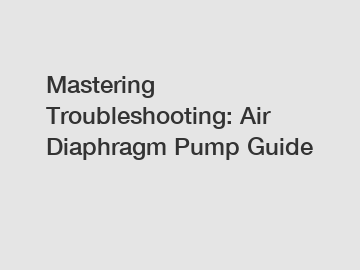Dec. 28, 2023
Energy
GK are exported all over the world and different industries with quality first. Our belief is to provide our customers with more and better high value-added products. Let's create a better future together.
Mastering Troubleshooting: Air Diaphragm Pump Guide.
Air diaphragm pumps are an important component in many industries, utilized for transferring fluids, slurries, and viscous materials. As with any mechanical equipment, troubleshooting issues can arise, causing downtime and hampering productivity. To ensure smooth operations and boost efficiency, it is essential to master the art of troubleshooting air diaphragm pumps. In this guide, we will explore common problems encountered with air diaphragm pumps and provide valuable tips to tackle them effectively.

1. Insufficient Flow Rate.
A common issue faced with air diaphragm pumps is insufficient flow rate. This can be caused by various factors, including clogged suction or discharge lines, worn-out diaphragm plates, or a damaged air valve. To address this problem, start by checking and cleaning the suction and discharge lines. If the issue persists, inspect the diaphragm plates for signs of wear and tear and replace them if necessary. Additionally, ensure that the air valve is in good condition and functioning properly.
2. Leaks.
Leaks are another common problem encountered with air diaphragm pumps. These can occur at different points, such as the pump body, diaphragm, or connections. To identify the source of the leak, carefully inspect the pump while it is running. Once the location of the leak is determined, tighten any loose connections and replace faulty gaskets or seals. Regularly inspecting the pump for leaks and promptly addressing them can prevent further damage and improve overall performance.
3. Irregular Pumping Action.
Irregular pumping action can be attributed to a variety of factors, such as a malfunctioning air valve, inadequate air supply, or damaged diaphragm. Begin troubleshooting by ensuring that the air valve is operating correctly and providing a consistent air supply. If the air valve appears to be functioning correctly, inspect the diaphragm for signs of damage or wear. Replacing the diaphragm should resolve the issue and restore regular pumping action.
4. Excessive Noise and Vibrations.
Excessive noise and vibrations can disrupt the working environment and indicate underlying problems with the air diaphragm pump. The most common causes of noise and vibrations are misalignment, loose parts, and worn-out components. Start by checking and realigning all components, such as the motor, pump, and drive parts. Tighten any loose connections and inspect all moving parts for signs of wear. Replace any damaged or worn-out components to eliminate noise and vibrations.
5. Inconsistent or Fluctuating Pressure.
Inconsistent or fluctuating pressure can hinder the performance of air diaphragm pumps. This problem can be caused by a faulty pressure regulator, inadequate air supply, or worn-out diaphragms. Begin by checking and adjusting the pressure regulator to ensure it is functioning properly. If the pressure regulator is in good condition, inspect the air supply to ensure it meets the pump's requirements. Finally, examine the diaphragms for signs of wear and replace them if necessary.
In conclusion, mastering troubleshooting techniques for air diaphragm pumps is crucial for maintaining their optimal performance. By addressing common issues such as insufficient flow rate, leaks, irregular pumping action, excessive noise and vibrations, and inconsistent pressure, you can ensure smooth operations and maximize productivity. Regular maintenance, including inspection and replacement of worn-out components, is essential in preventing major breakdowns and minimizing downtime.
If you require further assistance or have any questions regarding air diaphragm pumps, please do not hesitate to contact us. Our team of experts is readily available to help you troubleshoot and optimize your pump performance.
For more Sanitary Diaphragm Pumpinformation, please contact us. We will provide professional answers.
Previous: Which high-voltage lithium battery pack offers the best performance for B2B buyers in France?
If you are interested in sending in a Guest Blogger Submission,welcome to write for us!
All Comments ( 0 )